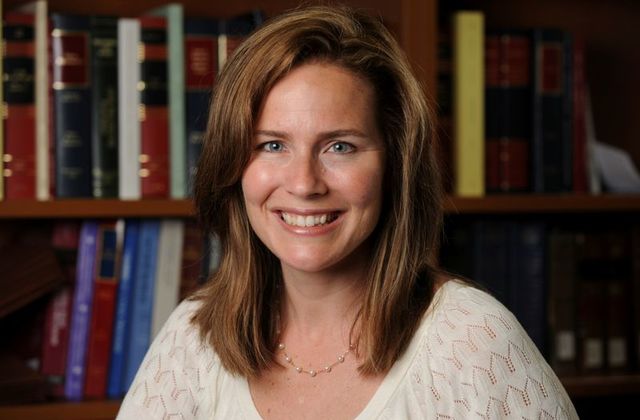WASHINGTON, D.C. (REUTERS) — On Saturday, President Trump plans to name conservative appellate judge Amy Coney Barrett as his third U.S. Supreme Court appointment, setting off a scramble in the Republican-led Senate to confirm her before Election Day in 5-1/2 weeks.
Senate Majority Leader Mitch McConnell has made confirming Trump’s judicial nominees a top priority and Judiciary Committee Chairman Lindsey Graham, who mounted an angry defense of Trump’s last high court nominee Brett Kavanaugh in 2018, has signaled he expects to have Barrett confirmed as a justice by Nov. 3.
Barrett, 48, was appointed by Trump to the Chicago-based Seventh U.S. Circuit Court of Appeals in 2017 and is a favorite of religious conservatives, a key Trump voter bloc. Her confirmation to replace liberal icon Ruth Bader Ginsburg, who died at age 87 on Sept. 18, would make Barrett the fifth woman ever to serve on the top U.S. judicial body and push its conservative majority to a commanding 6-3.
Trump plans to formally introduce his nominee at a 5 p.m. (2100 GMT) White House ceremony. Conservative activists hailed Trump’s selection, which surfaced on Friday night, while liberals voiced dismay.
Trump’s fellow Republicans hold a 53-47 Senate majority, and only two Republican senators have opposed proceeding with the confirmation process. Democrats, however, can be expected to make the process as difficult as possible.
Democrats, still seething over McConnell’s 2016 refusal to consider President Obama’s Supreme Court nomination of Merrick Garland because it came during an election year, will raise objections to Barrett, but have scant chances of blocking confirmation. Democratic presidential candidate Joe Biden has said the winner of the election should get to replace Ginsburg.
Trump’s fellow Republicans hold a 53-47 Senate majority, and only two Republican senators have opposed proceeding with the confirmation process. Democrats, however, can be expected to make the process as difficult as possible.
Abortion rights advocates have worried that Barrett could cast a vote for overturning the 1973 landmark ruling legalizing abortion nationwide.
On the Seventh Circuit, Barrett has staked out conservative legal positions in three years on the bench, voting in favor of one of Trump’s hardline immigration policies and showing support for expansive gun rights. She also authored a ruling making it easier for college students accused of campus sexual assaults to sue their institutions.
Like Trump’s two other appointees, Neil Gorsuch in 2017 and Kavanaugh in 2018, Barrett is young enough that she could serve for decades, leaving an enduring conservative imprint. Barrett would be the youngest Supreme Court nominee since conservative Clarence Thomas was 43 in 1991.
A devout Roman Catholic, she and her lawyer husband have seven children, two of whom were adopted from Haiti. Born in New Orleans, Barrett received her law degree from Notre Dame Law School, a Catholic institution in Indiana.
The other finalist mentioned by Trump to fill the vacancy was Barbara Lagoa, a Cuban-American federal appeals court judge from Florida who he appointed last year.
Election-related cases
I think it’s very important that we have nine justices — President Trump
Trump has said he wants his nominee confirmed before the election so she would be able participate in any election-related cases that reach the justices, potentially casting a key vote in his favor. The outcome of a U.S. presidential election only once has been determined by the Supreme Court, in 2000 when it clinched Republican George W. Bush’s victory over Democrat Al Gore.
“I think it’s very important that we have nine justices,” Trump said on Wednesday.
Early voting already has started in some states. Trump has repeatedly without evidence said voting by mail, a regular feature of American elections, will lead to voter fraud. He also has refused to commit to a peaceful transfer of power should he lose the election.
This marks the first time since 1956 that a U.S. president has moved to fill a Supreme Court vacancy so close to an election. In that year, President Dwight Eisenhower, three weeks before winning re-election, placed William Brennan on the court using a procedure called a “recess appointment” that bypassed the Senate, a tactic no longer available for installing justices.
Filling the court’s vacancy has given Trump, who is trailing Biden in opinion polls, a chance to shift the focus of voters away from his handling of the coronavirus pandemic.
An emboldened Supreme Court conservative majority could shift the United States to the right on hot-button issues by, among other things, curbing abortion rights, expanding religious rights, striking down gun control laws and endorsing new restrictions on voting rights.
If re-elected, Trump would get to make additional Supreme Court appointments if further vacancies arise. If he gets to replace the court’s current oldest member, 82-year-old liberal Justice Stephen Breyer, Trump could expand the conservative majority to 7-2.






Leave a Reply